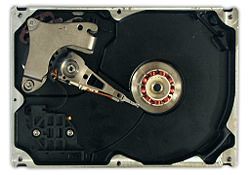
A hard disk drive (HDD), commonly referred to as a hard drive.The platters are spun at very high speeds. Information is written to a platter as it rotates past devices called read-and-write heads that operate very close over the magnetic surface. The read-and-write head is used to detect and modify the magnetization of the material immediately under it. There is one head for each magnetic platter surface on the spindle, mounted on a common arm. An actuator arm moves the heads on an arc across the platters as they spin, allowing each head to access almost the entire surface of the platter as it spins. The arm is moved using a voice coil actuator or a stepper motor. Stepper motors were outside the head-disk chamber, and preceded voice-coil drives. The latter, for a while, had a structure similar to that of a loudspeaker; the coil and heads moved in a straight line, along a radius of the platters. The present-day structure differs in several respects from that of the earlier voice-coil drives, but the same interaction between the coil and magnetic field still applies.Capacity of a hard disk drive is usually quoted in gigabytesThe data transfer rate at the inner zone ranges from 44.2 MB/s to 74.5 MB/s, while the transfer rate at the outer zone ranges from 74.0 MB/s to 111.4 MB/s. An HDD's random access time ranges from 5 ms to 15 ms.
No comments:
Post a Comment